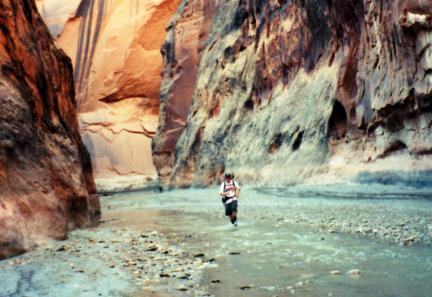
For some of these yearly backpacking trips, I became pretty serious about getting in shape. For multiple mornings a week I would run back and forth on a paved road near my house along Utah Lake. I progressed to the point where I was running four miles in about 32 minutes. I was pretty proud of that, but after each backpacking trip, I would fall back to lazy life. I didn’t really enjoy these pavement runs and I still had a problem in that I kept competing with the watch, trying to beat my times. It became harder and more painful. Another reason I would quit was because of illness. Back in those days with bad fitness, I would get frequent colds and that was an excuse to quit.
But one year, in 2002, something was very different. Perhaps it was the realization that I was starting to feel old. I was 43, between 220-230 pounds and would watch my kids run around in the back yard playing with my fit brother-in-law Ed. I couldn’t really join in if I wanted to. I was too heavy and out of shape to jump on our trampoline like I used to. As far as basketball goes, I could no longer even jump and touch the bottom of the net. Back in my early 20s I could come close to dunking a basketball. I kept trying to touch that net, but just couldn’t. It was depressing. When I tried to play basketball, I would quickly get injured and now in my 40s, it took much longer to heal. So I gave up basketball. Was this it? Was it all downhill for the years to come?
Memories of my 20s came back when I watched Ron Breon in his 40s run like the wind. He didn’t quit and curl up on a couch for the rest of his life. I observed some dedicated individuals who seemed to be out running on the streets or swimming in our neighborhood pool each day. I concluded it wasn’t too late to turn things around.

With a backpacking trip to the Wind River Range in Wyoming just a week away, I knew I better start getting in better shape or I would really fall behind the others all week. My thoughts turned to Mount Timpanogos and memories of an invitation I turned down to climb 22 years earlier. That mountain was calling me. There was some sort of connection I couldn’t explain, but I would understand it in the years to come. I did a little research, figured out where the trailhead was, and decided to climb it for the first time. I prepared a daypack because I had read it took about 10 hours or more. Early Saturday morning before dawn I was on the trail. My pace soon slowed, but I continued mostly non-stop. As I climbed above 10,000 feet, a group of young hikers who had continually stopped and rested, but always caught up to me commented that I was just like the “tortoise.” That hit me as an insult and was the wakeup call I needed. I was indeed a slow, fat, out of shape tortoise. I made it to the top and then slowly hiked down. When I reached home I felt physically sick and terribly worn out. What a humbling experience!

The following week I spent a wonderful time in the Wind Rivers with my buddies, Brad, his son, and Carl. The first day was torturous with an ill-planned route causing us to climb over hundreds of deadfall. But as the week went on I continued to push myself and at times was leading the pack.
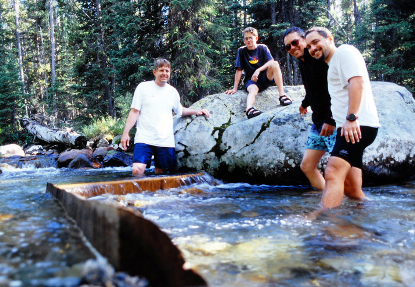
On the last day, we spent the afternoon building a dam across a stream. Boys will be boys. The hike gave me plenty of time to think. When I returned home, I was a changed man.
On the following Saturday, what did I do? I went right back up Mount Timpanogos once again. But this time I was amazed how much easier it was and I accomplished the trip several hours faster. A friend who knew I had backpacked the week before was surprised to see me on the trail. “What are you doing?” he asked. I explained that I was not going back to my old ways again but was going to keep on hiking.
My new focus was on fast power hiking in the mountains. That became my love. Most runners set a goal to run a marathon. That never at any time became a goal of mine. Thinking back, I’m amazed that I never considered it once. I had no interest in running on paved roads. I had never heard of ultrarunning and would not learn about it for another two years. I was simply interested in being able to go very long distances fast in the mountains and canyons.
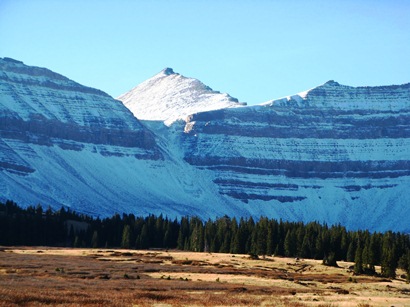
Within only one month an idea came into my mind. Back in 1996 when I hiked Kings Peak for the first time with my buddies I had observed a guy who was doing the hike in only one day. It had taken him all day, but he had accomplished it. That captured my imagination and even though I was very early in improving my fitness, I believed I could do it. In mid-September I headed to the trailhead to climb that highest Utah peak solo in one day. Memories of my multi-day painful trip six years ago came back to me as I began my quick journey up the trail at about 2:30 a.m. Overnight it had rained and as I discovered soon, it snowed above 10,000 feet. I made good progress but became chilled and experienced some hypothermia for the first time. But I put on warmer clothes and arrived at Gunsight Pass (11 miles) just before dawn. But being inexperienced, the snow surprised me and as I was approaching the base of the peak near Andersen Pass, I was trudging through snow about a foot deep. I had to turn back a mile short of my goal. But as I returned, I met various groups heading up who were amazed to see me coming down and learned that I had started from the trailhead. They were very impressed, a very different reaction from just a month earlier when I was called a tortoise. The final three miles were the most slow, painful three miles I had ever experienced up to that time. I had tried to go too far, too soon, but I was pleased with my accomplishment.
A couple weeks later, in the late afternoon I ran the high trails above Millcreek Canyon, a canyon near Salt Lake City, Utah. I truly ran and had an amazing time running among the fall colors on the Desolation Trail from Porter Fork to Dog Lake. I had never gone that long stretch before in one trip. Dark came and I ran via headlamp down to Little Water. By that time I was thrashed with a blister and hitched a ride down the canyon to my dad’s cabin. This was my first experience running trails in the Wasatch Mountains on September 27, 2002.
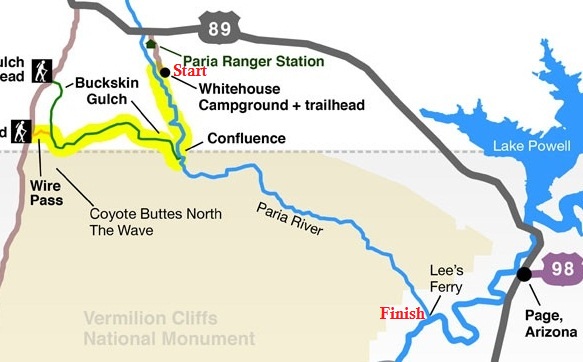
I next put in my mind the idea of running many of my past backpacking trips. Instead of taking several days and time away from work, I believed I could do the route in a day. My first trip was spectacular Paria Canyon, the site of my first long backpacking trip in 1995. Ed agreed to join me and I just couldn’t wait for the day to arrive. Instead of three days, we would aim to run Paria canyon all the way to Lees Ferry in a day and a half.

It felt like I was in heaven jogging through the canyon, singing tunes playing from my portable CD player (which later sucked in the sand and scratched all my discs). We passed many backpackers who had been traveling for a couple days. They stared at us as we ran by with our very light packs, wondering how far we were going. Up to that time, this was the most amazing and fun outdoor activity I had ever been on. But by mile 25, my knee started to hurt terribly. I knew nothing about leg injuries but I had a terrible case of ITBS caused by increasing your mileage too fast. I limped very painfully for the remainder of the 42 miles to Lee’s Ferry.
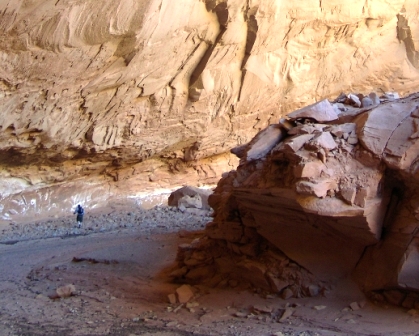
- In giant alcove in Lower Muley Twist
I had experienced my first running injury and my lack of patience wouldn’t let in completely heal for months. But I was completely hooked and wouldn’t look back. I had experienced the joy of running/hiking long distances on trails and saw that a new world had been opened up to me. After tasting this amazing experience, I wanted to share what I discovered with others. First, I convinced Brad and David, my backpacking buddies, to ditch their heavy boots for running shoes and go fast pack Lower Muley Twist with me in Captital Reef National Park. This is one of the lesser-known parks in Utah. The park is in a remote area of south-central Utah that did not have a paved road going to the area until 1962. It is still a relatively secret national treasure compared to the other well-known parks in Utah. It is a runner’s paradise because of its solitude, spectacular scenery, primitive and rugged trails, slot canyons, and gorgeous slick rock. The major feature of the park is the Waterpocket Fold. This is a remarkable, nearly 100-mile long up-thrust extending like a rugged spine for 100 miles. In the middle of the Fold is Muley Twist Canyon which gets its name from pioneer days because it was so twisting it could twist up a mule train.
Brad and David were skeptical about this approach, fast packing, but came with me and observed the change already in my fitness. They would laugh as I kept running ahead, having a blast, running down the canyon. We accomplished accomplished the 15 mile loop and had a fantastic time.
I did a little mid-week running in the neighborhood but not much. It was so much less enjoying than running on trails. But also, still over weight, my joints just couldn’t stand the pounding of daily running. So, I turned to swimming. I had not done any serious swimming since the 6th grade, so I was starting at nearly square one. There was a small group of guys at my neighborhood pool that would swim laps and get tips from the local high school swim coach who would do this service in exchange for letting the team use our pool for practices. I quickly got better and progressed to the point where I could swim a mile at a time. My fitness improved greatly and the pounds started to shed little by little. During these first six months of my life-changing fitness, I swam more than 100 miles.

In the weeks to come I would persuade others to join me on these quick long outdoor adventures. Even though it was now winter (2002-2003), it didn’t stop me. We ran in places such as: Lake Mountain, the Oquirrh Mountains, the Tintic Mountains, and Price River. In southern Utah where it was warmer, Kolob Arch in Zion National Park, and Huber Wash with it’s amazing petrified forest. On that last event, for excitement when we returned to the trailhead our vehicle was gone. We reported it stolen and then tried to figure out how we would get home. But a half hour later we were informed by a group of guys laughing, that our car was actually around the next corner at a different trailhead. We had not come out at the right place.
Each week or two, I wanted to do another adventure run but it became harder to find anyone who had the time or could do the miles. Besides those who I brought along with me, I still had never yet seen another trail runner on my adventures. I almost believed that I was doing a sport of my own creation. I knew there must be others but didn’t know how to find them, so more and more of my runs would be solo.

